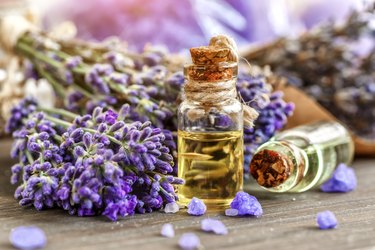
Aromatherapy and the use of essential oils began in ancient times with the Egyptians who extracted oils from plants to create medicine and cosmetics. Since the Egyptians, research has given us a better understanding of the uses and benefits of essential oils in our everyday lives. The lack of enforcement of quality guidelines has allowed the production of fake essential oils and imitation products that may look real, but don't offer the same benefits. These fake lavender oils are made up of chemicals that can harm your skin and should not be used for anything but home fragrance.
Real lavender essential oil has many health benefits such as helping to manage pain, relieve tension and sooth respiratory problems. There are a few things that you can do to protect yourself from buying a fake and they all start with getting the facts. If you are using lavender essential oil for healing, read the product's label before you buy it.
Video of the Day
Video of the Day
Step 1: Find Reputable Companies
Buy essential oil from well-established companies. These companies are more likely to follow the Food and Drug Administration (FDA) guidelines. Ask your supplier questions; they should be able to tell you who supplies their products and how they are made. Most lavender essential oils come from Europe with a small amount coming from the Pacific Northwestern United States.
How is lavender oil made? There are four methods of lavender oil extraction. Hydro distillation is where the plants are boiled in water then strained. The resulting liquid is considered hydrosol oil and is not considered true essential oil. Solvent extraction is when the plant is broken down with natural solvents to extract the oil. The oil is extracted for food flavoring and should not be used for healing purposes.
Supercritical extraction uses high pressure and carbon dioxide to extract the oil. This creates oleoresins, which are a mix of plant resin and essential oil, a low-quality essential oil that smells good but has few healing properties. Steam distillation uses a large pressure cooker to extract a few drops of oil out of each plant. This is the traditional method for extracting high-quality essential oil.
Step 2: Consider Lavender Oil Pricing
Check the price. True lavender oil is not cheap. As of 2019, a 10 millileter bottle of real essential lavender oil costs between $8 and $18. This can vary by retailer. If the price seems too low to be real, then it probably is.
Step 3: Read the Label
Check your bottle's label. If it says "perfume, perfume oil, fragrance oil or scented oil," it is artificial and not pure essential lavender oil.
Step 4: Research Oil Origins
Find out where the oil came from. Labels should clearly state the product's country of origin. Most lavender oils come from France, England or Mediterranean countries. Some lavender oil producers are located in the United States, but are rare because of climate-related issues that cause fungal infection in the plants.
Step 5: Check for Lavender's Latin Name
Look for the lavender plant's Latin name. Real lavender essential oil is extracted from one of the following: English lavender (Lavandula angustifolia or Lavandul officinalis), French lavender (Lavandula stoecas), lavandin hybrid (Lavandula hybrida), spike lavender (Lavandula spica) or a combination of two different lavenders.
Step 6: Dangers of Fake Lavender Oil
Avoid buying a product if you are not sure about its use on the skin. Real lavender oil will cause skin irritation or a rash if placed directly on the skin; it must be diluted with carrier oils such as grapeseed or olive oil before application.
Fake oils are full of chemicals that can damage your skin. Fake oils and fragrances contain chemicals such as benzene, which can cause leukemia, and phthalates, which can interfere with fetus and infant development.
Warning
A lavender essential oil can irritate your skin if not diluted in a carrier substance.